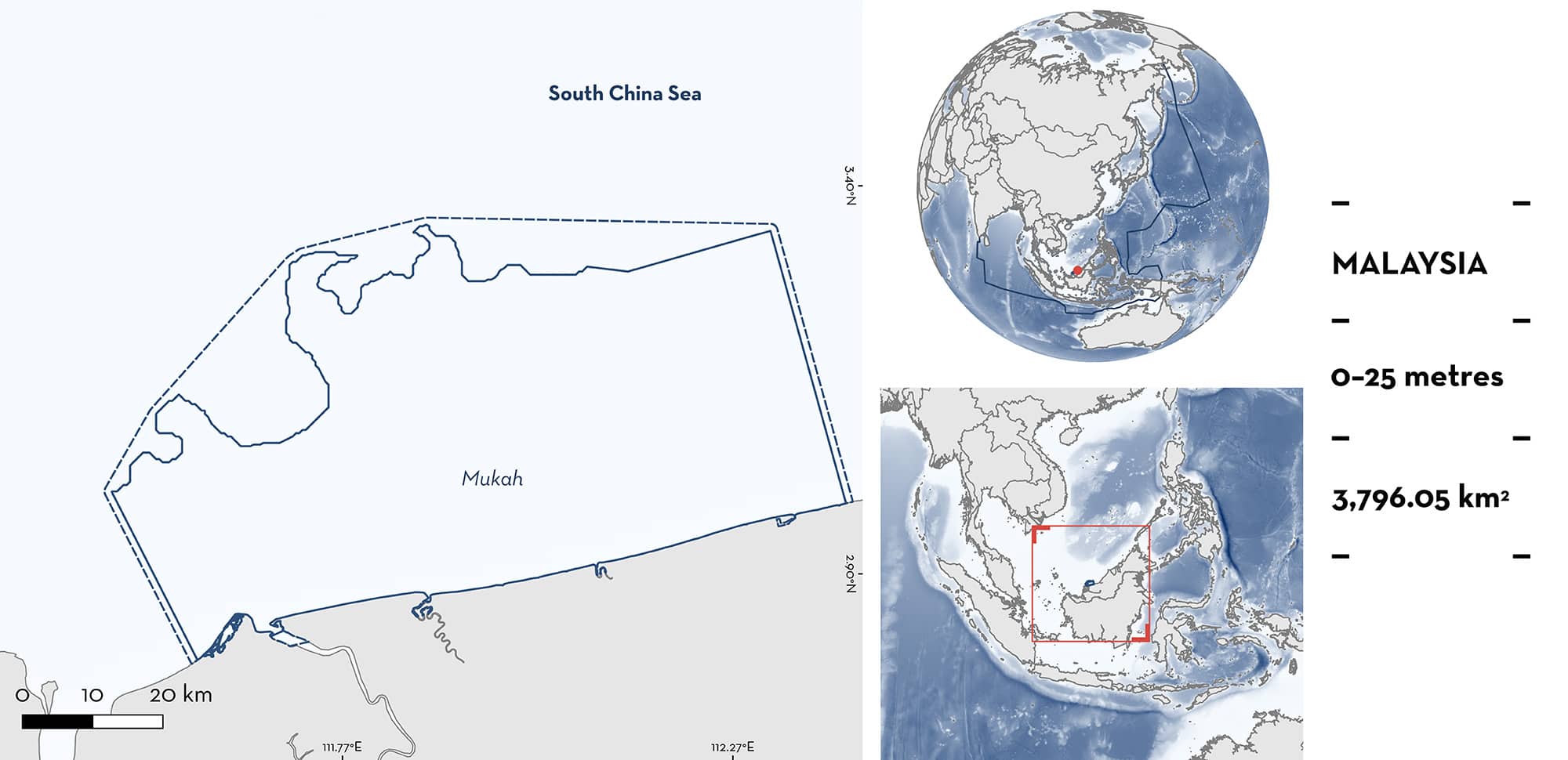ISRA FACTSHEETS
ISRA FACTSHEETS
ASIA REGION
Mukah
Summary
Mukah is a coastal area in northern Sarawak, Borneo, in Malaysia. The habitat is characterised by shallow (<25 m depth) water with sandy and muddy substrates, coastal mudflats, peatland-draining estuaries, and mangrove habitats. The area is influenced by the monsoon regime, and the surface circulation is generally towards the northeast. Within this area there are: threatened species and reproductive areas (Scalloped Hammerhead Sphyrna lewini).
Download factsheet
Mukah
DESCRIPTION OF HABITAT
Mukah is a coastal area in northern Sarawak, Malaysia. The area is characterised by a wide and shallow continental shelf (Garces et al. 2006), with shallow water <25 m deep extending to ~40 km offshore. The coastline is primarily lined with mudflats and mangroves, and there are major peatland-draining estuaries (‘black water rivers’) (Martin et al. 2018), interspersed with sandy beaches and rocky shores. The shallow shelf in Mukah has sandy and muddy substrates (Department of Fisheries Malaysia 1999).
The area is influenced by the monsoon regime, with the northeast monsoon from November–February and the southwest monsoon from May–August. The surface circulation in shelf waters is generally towards the northeast (Pa’Suya et al. 2014).
This Important Shark and Ray Area is benthopelagic and extends from inshore and surface waters (0 m) to 25 m based on the bathymetry of the area.
CRITERION A
VULNERABILITY
One Qualifying Species within the area is considered threatened with extinction according to the IUCN Red List of Threatened Species. The Scalloped Hammerhead is assessed as Critically Endangered (Rigby et al. 2019).
CRITERION C
SUB-CRITERION C1 – REPRODUCTIVE AREAS
Mukah is an important reproductive area for one shark species.
Historical data indicate that Mukah has long been an important area for neonate and young-of-the-year (YOY) Scalloped Hammerheads. A survey in 2006 sampled 312 local gillnetters and found that 15% of their shark catch was Scalloped Hammerheads, with a total of 78.5 kg landed in three out of seven days of surveys (Arshad et al. 2006). Importantly, 100% of the measured individuals (n = 35) had a mean total length (TL) of 77.7 cm (Arshad et al. 2006). Size-at-birth for the species is 31–57 cm TL (Ebert et al. 2021) and they have a fast initial growth rate of ~50–60 cm in the first year (Chen et al. 1990), showing that these were mostly neonates and YOY individuals.
Based on a combination of landing and market surveys in 2015, 2017, 2018, and 2019, regular contemporary catches of neonate and YOY Scalloped Hammerheads are reported from gillnets mostly in nearshore (<20 nautical miles) and shallow ((<25 m depth) waters (Booth et al. 2021; A Then unpubl. data 2023). Over four days of landing surveys in 2015, half of the 38 Scalloped Hammerheads recorded were neonates ranging from 49–57 cm TL and the other half were YOY ranging from 58–71 cm TL (A Then unpubl. data 2023). Similarly, landing surveys (n = 8) in Mukah in 2018–2019 recorded only neonates and YOY ranging from 51.2–88.0 cm TL (Booth et al. 2021). From the observed 2.81 individuals recorded per day of survey, a yearly catch of ~1,000 Scalloped Hammerheads was estimated (Booth et al. 2021). Recent local ecological knowledge obtained from interviews with 21 fishers (70% of surveyed fishers using gillnets in Mukah) indicate regular catches of Scalloped Hammerheads (2–30 individuals per month per fisher) (A Then unpubl. data 2022). Fishers estimated the average size to be ~50 cm TL, highlighting that they capture neonates and YOY individuals (A Then unpubl. data 2022).
Download factsheet
SUBMIT A REQUEST
ISRA SPATIAL LAYER REQUEST
To make a request to download the ISRA Layer in either a GIS compatible Shapefile (.shp) or Google Earth compatible Keyhole Markup Language Zipped file (.kmz) please complete the following form. We will review your request and send the download details to you. We will endeavor to send you the requested files as soon as we can. However, please note that this is not an automated process, and before requests are responded to, they undergo internal review and authorization. As such, requests normally take 5–10 working days to process.
Should you have questions about the data or process, please do not hesitate to contact us.


